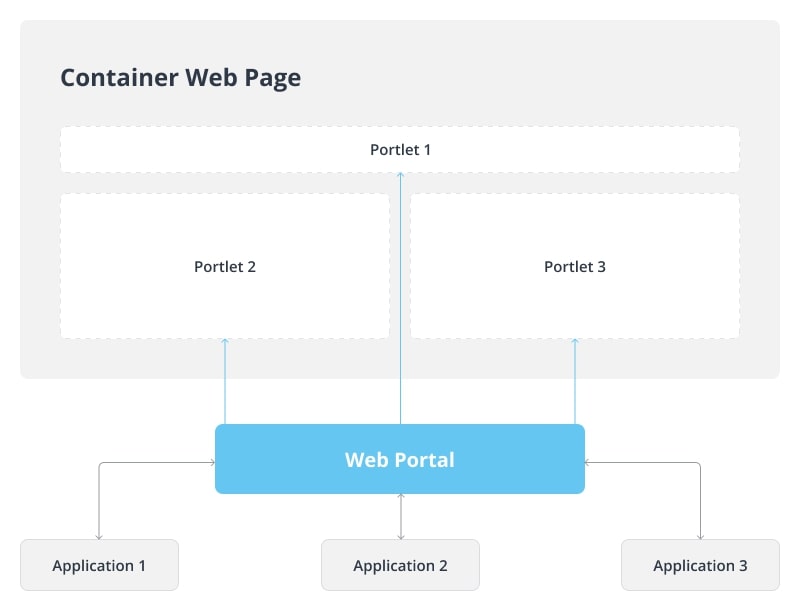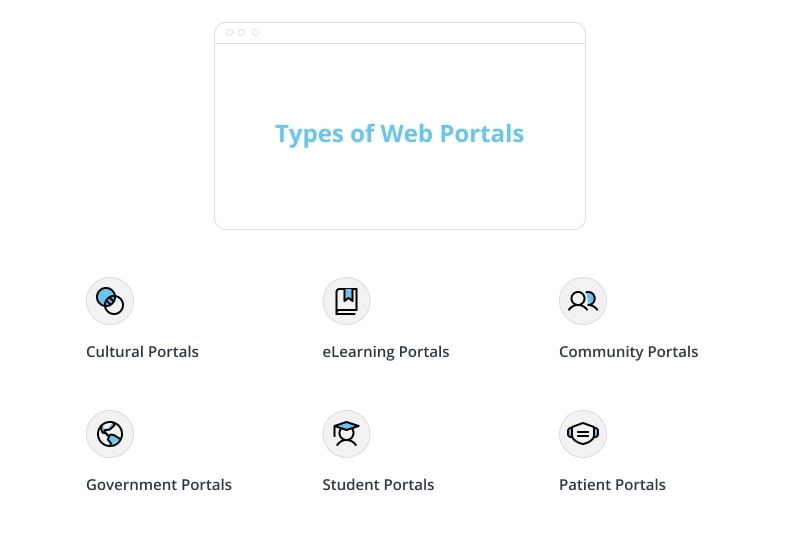What is a Web Portal and Why is it Beneficial for Business?

Head of Web Development Department
Reading time: 10 min
Nowadays, to stay afloat, businesses must expand their reach not only in territorial units but throughout the internet. Around 80% of respondents to the Microsoft survey prefer companies that maintain a web portal. 90% of global average respondents expect a brand to have a web portal. 74% of the global average responded using self-service web portals. It’s clear that there is a large demand for web portals so, as a business owner, you should at least consider setting one up.
In this article, we’re going to discuss the definition, types, and work principles of web portals. We will also present web portal examples and benefits that they can bring to a business.
What is a web portal?
First off, let’s define what a web portal is. A web portal is a website that collects information and services about a certain theme and provides access to such information and services to the portal’s users. Web portals often include features like web search, mail services, news, forums, and more.
The idea behind a web portal is to offer as many internet services as it can to attract and keep as many users as possible. There are two kinds of web portals:
- Horizontal. These portals are intended for everyone to use and contain content suitable for the public. They are similar to mass media but more interactive;
- Vertical. These portals are created for narrowly focused target audiences that are interested in a certain theme or business. B2C (business-to-client) and B2B (business-to-business) applications may be classified as vertical web-portals.
How does a web portal work?
Every web portal has three main criteria to answer:
- Integration — serves to fill pages with content, uniting system and customer;
- Consistency — defines an unchanging look of all system components;
- Personalization — achieved by the usage of personal accounts. A customer’s experience can be tailored to their interests in two ways. First, by observing biographical data provided by customers themselves and second, by tracking actions that they performed on a portal.
Web portals offer an access point to various types of content and services. The content of a web portal is dynamically managed through the use of databases, application windows, and cookies. Information within a web portal is often organized into channels, which are customizable page containers where specific information is loaded (portlets). Such channels categorize available information. Thus, they help search systems and customization options.
Overall, web portal development is about creating an integrated platform. Below you can find an abstract view of a web portal that connects simultaneously to multiple applications, gets a response, processes it, and integrates the result in portlets.
The web portal communicates with multiple applications that generate content for portlets via various protocols: generic web request, SQL database access, COM local call, and others. Protocols are used to create a network of links that will be integrated as banners and displayed, in turn, to users.
Advantages of using a web portal for business
The main advantage of web portals is customer acquisition. A growing number (81%) of online shoppers conduct brand research before visiting shops and making major purchases, according to a GE Capital Retail Bank’s annual Major Purchase Shopper Study. This means that the web portal alone can help you increase customer loyalty to your brand and attract new buyers.
Other benefits of portals include:
- Personalized, user-specific content for your clients. Web portals usually revolve around their users. They locate and remember customer-specific information. The content changes to answer users’ requests and allows them to add personalized product promotions;
- Cheap customer self-service. Portals can be filled with FAQs, manuals, information about companies and products, every bit of data that customers may need and find on their own. This will lift some of the burdens from call centers too;
- Agility. Online portals can be used to support customer experience from multiple platforms, including mobile;
- Communities. With forums, customers will learn from other customers or seek help from customers who experienced similar problems, further reducing the burden on the support staff.
Types of web portals with examples
There are more portal types than discussed below, but we will only be addressing the most popular ones.
1. Cultural portals
Cultural portals accumulate and present digitized collections of libraries, galleries, and museums. Such portals include photos, scans, journals, sound recordings, and films as well as information about authors, publishers, and more. One of the best web portals is Europeana, a cultural portal for the European Union.
2. eLearning portal
Nowadays people tend to use the internet as a tool for learning. This is where e-learning portals come in, providing various services from common knowledge and educational apps to scientific articles for everyone to use. An example of an e-learning portal is Cosmolab, the scholarly article database in the form of a web portal that we created.
3. Patient portals
Private health centers use these portals to establish contact between patients and medical staff. Centers publish information on work hours, available services, and pricing. Patients log in to book appointments, examine health assessments and medical analysis results. An example of such a portal is MobaNode, the solution for healthcare we developed. The platform can be used by patients to receive information as well as recommendations and by medical personnel to renew patient prescriptions automatically, send them notifications to pick up prescriptions, and monitor prescription intake compliance.
4. Community portals
These types of portals provide a sense of community to those who access them. These communities may connect people from all over the world based on their interests. Visitors share experiences, pictures, give advice and seek help. The Recipe Diva is a cooking social network that is a community web portal solution our development team created. On this portal, people can find, showcase and discuss recipes. Using Drupal, Azoft specialists created a functional, stable, and robust website in a limited time.
5. Government portals
Governments create and maintain these types of portals for citizens. They present information and online services from the government. This is where citizens can find and access healthcare, information on taxes and child support, apply for social welfare and even conduct job searches. One of the most notable examples is the Australian government’s portal.
6. Student portals
These portals are intended exactly for what you would expect, students. They are usually provided by universities and colleges to help students find all the relevant information about enrollment, training, courses, timetables, etc. For example, MIT built a portal for student applications.
How do you build a web portal?
Let’s discuss the general steps of web portal development.
Define goals
Establish the portal’s purpose by answering the following questions:
- What type of portal will it be?
- What’s your target audience?
- How will the portal be useful to customers?
- What features are you going to add?
Pick your tech stack
Web portals can be built using a lot of easily accessible toolkits. For example, simple web portals can be built with a popular CMS. The web portal technology stack that we use for the creation of web portals includes PostgreSQL, PHP 7.2-8, Yii2, Bootstrap, tree, Vue.js, Sphinx, and more.
Development
At this stage, you might wonder if your skills are sufficient to shape the chosen stack into a working web portal. Don’t hesitate in looking for help from outsourcing companies to ensure the best customer experience.
Fill portal with information
When the carcass for the portal is complete, add all the necessary information that your customers might be interested in, start forum threads and provide FAQs.
Marketing
This stage is optional, but if you can afford it, you can improve portal recognition with advertisements and traffic exchanges.
Wrapping up
Web portals provide a unique customer experience and help create a self-sufficient brand-loyal community. If you’re considering developing your own web portal or need help deciding which type of portal will better suit your needs, contact us at info@azoft.com and we will gladly help.




Comments